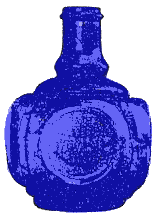
 |
Fire GrenadesWritten by Bob and Phoebe Adams |
Examples of glass fire extinguishers are to be found at bottle and insulator shows and are a very interesting example of the glass blowers art. There are three examples in the Adams household and they are a center of conversation whenever our family and friends gather.
Fire is the greatest foe that has alarmed mankind for centuries. In early England, the people turned to the grenade, which was a bottle made of thin and fragile glass that was designed to be thrown on the fire and to break easily and spew the contents at the base of the fire and quench the flames. Because of this unique use, the grenades were designed to be light and easily handled. These grenades were to be found in homes, hotels, factories, schools, trains and other commercial buildings around the turn of the century.
Basically, the fire grenade works by robbing the fire of its oxygen. Various fluids have been used in the grenade and the most effective was found to be carbon tetrachloride. In more recent years, it has been found that the carbon tet, when inhaled, can cause many respiratory problems. The liquid was then changed to salt water in most cases. NOTE: CAUTION IS SUGGESTED IN HANDLING ANY OF THE FIRE GRENADES.
The grenades are very collectible as they were made in many colors and many unique shapes and patterns to insure proper usage when thrown on a blaze. Many grenades are embossed with the name of of the manufacturer such as Harden's, Hayward's, Babcock, Harkness, Little Giant, Comet, to name a few.
These beautiful and useful glass products have been gradually replaced by the metal fire extinguisher as we know it today. The glass fire grenades were made to be broken and destroyed as they served their utilitarian purpose. However, there are enough examples remaining in very old homes and historic commercial buildings to attract great interest in these bits of history.
![]() Return to the Insulator Go-with's
page
Return to the Insulator Go-with's
page
If you have questions or comments, please use this Feedback Form.
Written Tuesday, March 11, 1997